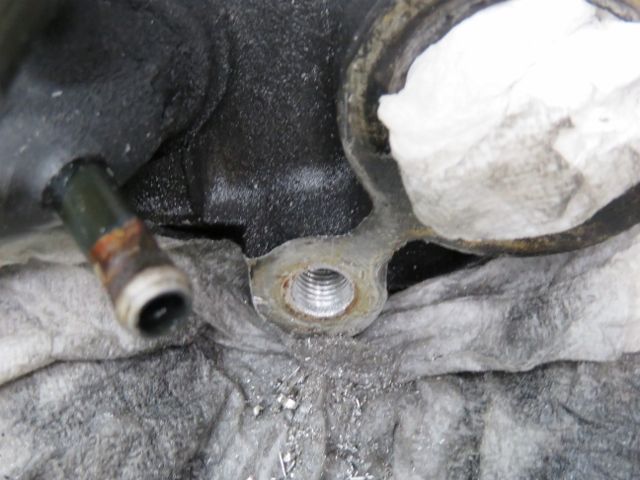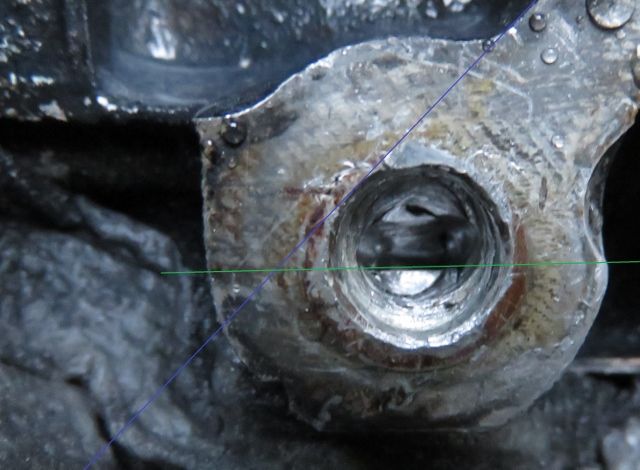Well done its good to see someone thinking outside the box.cmm303 wrote:Maybe I'm posting this too soon but .....
Using this little diamond thingy and a £15 not-a-dremel from ebay the neighbours probably thought I had taken up dentistry
and with a little tidying with a rod shaped diamond grinder I created a slot in the extractor
20 minutes later after freeing up my completely seized impact hammer, in 5 mins I had this, once I had extracted the stuck screwdriver bit from the hole with mole grips. Also it only took little taps to get this result.
To me that looks like movement which is pleasing though it looks like the extractor has gone further in. Nevertheless that helps to differentiate stud from extractor and I can get to work on the sidewalls to free it up more.
Big thanks to Northern B for encouraging me to take a photo, albeit for posting here for a laff, but photos have turned out to be really helpful in seeing what's going on.
Exhaust Manifold stud gawn?
Moderators: Doone, westonwarrior
Re: Exhaust Manifold stud gawn?
Re: Exhaust Manifold stud gawn?
Sorted the broken extractor. Stud was a bit loose in the thread so put in helicoil.
Checking manifold torque settings. 19-22Nm is not a lot. Converting for my torque wrenches, that is 2 metre kilograms if I have got my sums right. Not even on the scale.
Hope I have got that right?
Checking manifold torque settings. 19-22Nm is not a lot. Converting for my torque wrenches, that is 2 metre kilograms if I have got my sums right. Not even on the scale.
Hope I have got that right?
Chris with BertieB
'96 White unconverted AFT 2.5L Diesel 4WD
'96 White unconverted AFT 2.5L Diesel 4WD
Re: Exhaust Manifold stud gawn?
1.9 to 2.3 kg.m according to the Service Manual.....page 69
Re: Exhaust Manifold stud gawn?
Well done getting it out. 
Re: Exhaust Manifold stud gawn?
Thanks. As i thought. That's a light touch!
Chris with BertieB
'96 White unconverted AFT 2.5L Diesel 4WD
'96 White unconverted AFT 2.5L Diesel 4WD
Re: Exhaust Manifold stud gawn?
I appreciate that what follows is unsolicited but I thought it might be helpful to capture and share the benefits of this broken stud extractor experience because I read very little on the tinterweb that turned out to be helpful.
This applies when the extractor (or Easy Out) is broken off inside the hole.
The good advice on the internet is you can't readily drill a broken extractor! The advice I could not make work was Carbide or Cobalt drills which were reported to work on hardened material, which they do but with a lot of caveats. I suppose every scenario is different.
 What did work for me:
What did work for me:
 What did not work for me:
What did not work for me:
Diamond spherical grinder - 1mm dia upwards. Readily available, often as engraving bits. I read that diamond bits clog in soft metal so kept it for working on the extractor.

Carbide spherical burr - 2mm dia upwards. Available from ebay seller glostertooling. These were excellent on the extractor and stud material. They didn't break in spite being small diameter. I did try a cylindrical or tapered carbide burr, it cut well but broke when it kicked back on a rough bit.

I mastered the right tools too late and with the material further down the hole it was increasingly challenging to do accurate work. If I had my time again (and I am not going to in a hurry!) I would:

I screwed a stud in as far as it would go (by hand) and backed it off a touch. It was much more wobbly than the other studs. Not wanting to risk the thread stripping I put in a thread recovery kit. Well worth the 20 mins.
Well known brand name is Helicoil. I used a Draper equivalent. At £20 from an agricultural place on Saturday morning it was much more expensive than on ebay.

This gave a lovely strong thread again.

... and Bongo is running quieter than ever now
This applies when the extractor (or Easy Out) is broken off inside the hole.
The good advice on the internet is you can't readily drill a broken extractor! The advice I could not make work was Carbide or Cobalt drills which were reported to work on hardened material, which they do but with a lot of caveats. I suppose every scenario is different.
- Grinding stones - cylindrical type
- Diamond grinders for Dremel type tool - used lots of water from a pressurised garden sprayer to lubricate
- Diamond cylindrical grinder - but wore out quickly, even lubricating as above
- Carbide spherical burrs
- Large, like 5.5mm carbide drill - cut away 2-3mm in 1hr approx
- Camera for close up pics to check what was really going on
- Tapping the extractor round with a punch to loosen it
- Trying to shatter the extractor
- Drilling with small carbide drills less than 3.5mm, just snapped
- Drilling round the side of the extractor into the "soft" stud
Diamond spherical grinder - 1mm dia upwards. Readily available, often as engraving bits. I read that diamond bits clog in soft metal so kept it for working on the extractor.

Carbide spherical burr - 2mm dia upwards. Available from ebay seller glostertooling. These were excellent on the extractor and stud material. They didn't break in spite being small diameter. I did try a cylindrical or tapered carbide burr, it cut well but broke when it kicked back on a rough bit.

I mastered the right tools too late and with the material further down the hole it was increasingly challenging to do accurate work. If I had my time again (and I am not going to in a hurry!) I would:
- Try to loosen the extractor by knocking it clockwise with a hammer and punch on any rough bit left.
- Smooth the face with a cylindrical grinding stone just enough to control the next step.
- Use a 1.5 - 2mm diamond spherical grinder to cut a groove across the face of the extractor, deep enough for a screwdriver to gain purchase. Let the tool do the work, pressure will not help. Square off the profile of the slot with either a pointy diamond bit or a cylindrical bit so the screwdriver does not cam out so easily. Lubricate with plenty of water as you go. Allow 1 hour.
- Using a screwdriver bit no wider than the diameter of the extractor, try to reverse out the extractor. Worth investing the time here because it will still be quicker than "drilling out". I used the technique successfully a cm into the hole. It was beyond getting the extractor out but it loosened it enough for me to clear away the soft stud round the edge.
- Depending on the diameter of the extractor, try grinding away some of the stud around the circumference of the extractor. The carbide burr is good and will also cope with the extractor as well. I tried drilling with 1.5-2mm drills, even with HSS drills and they kept breaking. Remember to lubricate with oil.
- If the screw driver approach will not budge it and there is not enough stud between the extract and the hole's thread, then you are left with having to "drill out". You are now looking at up to 6 hours work. You will get there even though it does not feel like it.
- in a Dremel try a larger carbide spherical burr (oil lube) or diamond one (water lube)
- I found Carbide conical burrs partly successful but tended to kick back, eventually breaking. (Don't be tempted by adverts for a "recovery bit". It is basically one of these at 10x price.)
- Also small grinding stones in a Dremel make headway
- I lost favour with drills. The small tools above give lots of control but if you want to give it a go then use a diamond bit to grind a centre point for the drill. Drill with a 4.5 to 5.5mm carbide drill slow speed. Lots of lubricant. 1 hour = 2-3mm depth and 1 drill bit (£12+).

I screwed a stud in as far as it would go (by hand) and backed it off a touch. It was much more wobbly than the other studs. Not wanting to risk the thread stripping I put in a thread recovery kit. Well worth the 20 mins.
Well known brand name is Helicoil. I used a Draper equivalent. At £20 from an agricultural place on Saturday morning it was much more expensive than on ebay.

This gave a lovely strong thread again.

... and Bongo is running quieter than ever now
Chris with BertieB
'96 White unconverted AFT 2.5L Diesel 4WD
'96 White unconverted AFT 2.5L Diesel 4WD
- Northern Bongolow
- Supreme Being
- Posts: 7722
- Joined: Mon Mar 15, 2010 11:33 pm
- Location: AKA Vanessa
Re: Exhaust Manifold stud gawn?
good job mate and thanks for showing how, it seems such an easy job when you first look at it, then the fun can start. 
 .
.
still, think of the garage bill you have saved, and learned a bit along the way. the things i learned when i did one was never offer the service to anyone else, especially a mate. and never use stud extractors they are sh*t if you are heavy with them or just unlucky.
still, think of the garage bill you have saved, and learned a bit along the way. the things i learned when i did one was never offer the service to anyone else, especially a mate. and never use stud extractors they are sh*t if you are heavy with them or just unlucky.
- mikeonb4c
- Supreme Being
- Posts: 22877
- Joined: Sun Nov 05, 2006 10:49 pm
- Location: Living with Mango Bongo in the North West but with a tendency to roam
- Contact:
Re: Exhaust Manifold stud gawn?
Brilliant write up. It should be made into a factsheet along with Adys final comment 



Re: Exhaust Manifold stud gawn?
Thanks for your support guys. It felt pretty lonely at times!
Put the post anywhere to demonstrate why extractors should be banned for any recessed stud!!
Forgot to emphasise need for SOLID carbide drill, not carbide tipped.
Put the post anywhere to demonstrate why extractors should be banned for any recessed stud!!
Forgot to emphasise need for SOLID carbide drill, not carbide tipped.
Chris with BertieB
'96 White unconverted AFT 2.5L Diesel 4WD
'96 White unconverted AFT 2.5L Diesel 4WD
Re: Exhaust Manifold stud gawn?
Really appreciate the ongoing info, great job, thanks Chris. 






